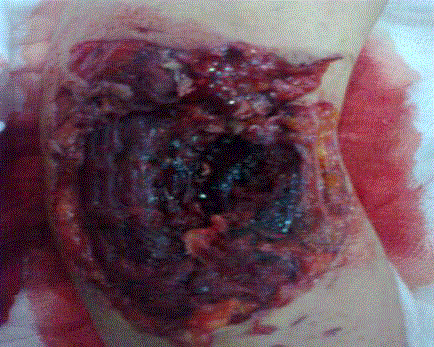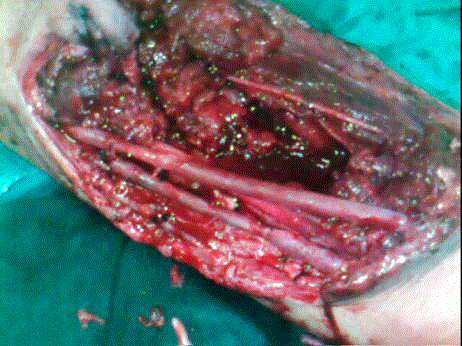Case Report
Management of Concomitant Brachial Artery and Brachial Vein Injury
Hasan Ekim1* and Meral Ekim2
1Department of Cardiovascular Surgery, Bozok University School of Medicine, Turkey
2Department of Cardiovascular Surgery, Meral Ekim, Bozok University School of Health, Turkey
*Corresponding author: Hasan Ekim, Department of Cardiovascular Surgery, Bozok University School of Medicine, Turkey
Published: 16 Jul, 2018
Cite this article as: Ekim H, Ekim M. Management of
Concomitant Brachial Artery and
Brachial Vein Injury. Clin Surg. 2018;
3: 2029.
Abstract
Traumatic brachial artery injury constitutes a relatively large proportion of peripheral vascular
injuries. We present a 23 year-old male patient who was referred to our hospital due to brachial
artery injury. He was immediately taken the operating room due to vascular injury with ischemia.
His injured brachial artery and vein were repaired using saphenous vein interposition grafts.
Postoperative recovery was uneventful. His brachial, radial and ulnar pulses were palpable. In
patients with concomitant brachial artery and vein injury, venous collateral circulation may not be
sufficient because of the accompanying large tissue defect. In this circumstance, both brachial artery
and brachial vein should be repaired without delay.
Keywords: Brachial artery; Vein; Vascular trauma
Introduction
Traumatic brachial artery and vein injury constitute a relatively large proportion of peripheral vascular injuries. Amputation of the arm was inevitable for many injured victims with brachial artery injury in American civil war [1]. There were no options for repair of brachial artery injuries at that time. The rate of amputation was greatly reduced by the application of vascular repair techniques during the Korean and Vietnam Wars. During the last decades, the rate of amputation in upper limb vascular injuries has minimized due to increased surgical experience [2]. Here, we present a patient with combined brachial artery and vein injury associated with extensive soft tissue damage.
Case Presentation
A 23-year-old male was referred to our hospital, nearly six hours after a firearm injury directed at his right arm. Although there was no active bleeding except oozing, he had an extensive soft tissue lost (Figure 1). Brachial, ulnar and radial pulses were absent. He had symptoms and signs of ischemia and median nerve irritation. The diagnosis of vascular injury was established by clinical and hand-held Doppler examination. He was treated with tetanus antitoxin and prophylactic antibiotic therapy started. Biochemical parameters were closely monitored as there were also crushed muscle injuries. He was immediately taken the operating room to avoid losing the golden time for vascular repair and was urgently operated on using general anesthesia with a severely decrease hematocrit (16%). Surgical exploration was performed at the injury site. Through a six cm long incision, the injured nonviable soft tissues were debrided, and the brachial artery and vein were dissected. A large amount of thrombi was removed from brachial artery using Fogarty catheters. Its proximal and distal segments were flushed using 0.1% heparin solution to avoid fresh thrombus formation. Heparin was also given intravenously for systemic anticoagulation, before clamping of the brachial artery. Brachial artery and vein were repaired using saphenous vein interposition grafts harvested from lower limb using polypropylene sutures (Figure 2). These repaired vessels were covered with viable muscle and soft tissue to prevent desiccation and disruption, as previously described [3]. Postoperative recovery was uneventful. His brachial, radial and ulnar pulses were palpable. Arterial and venous Doppler examinations revealed patent grafts. Although he experienced edema in the right upper limb, edema decreased gradually during the follow up period. The median nerve symptoms subsided. After he was discharged to home, oral anticoagulant therapy was continued for six months. When seen six months later he had a full range of movements at the injured limb and peripheral pulses were normal.
Discussion
Doppler ultrasonographic examination of the upper limb has been shown to be as specific as angiography in patients with brachial artery injury [2]. Angiography should be performed, when the definitive diagnosis cannot be made with Doppler examination. In patients with obvious vascular injury, as seen our patient, angiography may be a time consuming procedure. In this circumstance, the diagnosis of brachial artery injury can be established by clinical assessment and hand-held Doppler examination, so that ischemia time could be kept to a minimum duration. If there is an accompanying bone fracture, vascular continuity should be provided before skeletal repair to reduce ischemia time [4]. Combined injuries of the brachial artery and brachial vein should be operated on urgently to prevent possible complications such as amputation and life-threatening bleeding. Excessive tension at the anastomotic sites may lead to increased failure rate. Therefore, if the vascular defect is more than 5 mm, interposition graft should be performed instead of primary repair [5], as was done in our patient. Venous ligation may lead to increased venous hypertension, phlegmasia and compromised arterial flow [6]. Therefore, venous continuity should be preferred to avoid the potential for complications from venous hypertension or long-term disability. Even short-term venous graft patency may provide adequate venous return before the development of venous and lymphatic collateralization. [7]. Therefore, all major venous injuries should be repaired regardless of graft thrombosis risk, as was done in our patient. It has been observed that saphenous vein grafts have better patency rates and better resistance to graft infection compared with synthetic grafts [2]. Thus, a saphenous vein interposition graft should be selected instead of a synthetic graft for vascular repair. Additionally, thorough nonviable tissue debridement should be done to minimize risk of infection. If crushed skeletal muscle damage is also present, hyperpotasemia may develop, leading to life-threatening arrhythmias. For this reason, biochemical parameters should be assessed regularly to cope with life-threatening metabolic changes in patients with major vascular injury [8]. Patients with major vascular trauma are in hypercoagulable state due to a systemic response to injury [6]. If infection develops, bacterial toxins and soluble inflammatory mediators also contribute to the activation of coagulation [6]. Therefore, all precautions should be taken against the development of infection. Median nerve injury is generally associated with brachial artery injury because it courses with the brachial artery throughout its length [9,10]. Nerve injuries can lead to loss of function even in patients who had successful vascular repair. Therefore, treatment of nerve injury should not be neglected.
Figure 1
Figure 1
Preoperative view of the injured upper limb showing massive soft
tissue damage and numerous foreign bodies.
Figure 2
Figure 2
This operative photograph showing brachial artery and brachial
vein repaired with saphenous vein interposition grafts.
Conclusion
Brachial artery injuries may be repaired even after the golden time of vascular repair due to rich collateral circulation of the arm in most cases. However, in patients with concomitant brachial artery and vein injury, venous collateral circulation may not be sufficient because of the accompanying larger tissue defect. In these cases, both artery and vein should be repaired without delay.
References
- Zellweger R, Hess F, Nicol A, Omoshoro-Jones J, Kahn D, Navsaria P, et al. An analysis of 124 surgically managed brachial artery injuries. Am J Surg. 2004;188(3):240-5.
- Ergunes K, Yillik L, Ozsoyler I, Kestelli M, Ozbek C, Gurbuz A. Traumatic brachial artery injuries. Tex Heart Inst J. 2006;33(1):31-4.
- 3. Ekim H, Tuncer M. Management of traumatic brachial artery injuries: A report on 49 patients. Ann Saudi Med. 2009;29:105-9.
- Nagre SW. Brachial artery injury management-Case series. Ann Surg Int. 2016;2(1):1-5.
- Padayachy V, Robbs JV, Mulaudzi TV, Pillay B, Paruk N, Moodley P, et al. A retrospective review of brachial artery injuries and repairs- Is it still a training artery? Injury Int J Care Injured. 2010;41(9):960-3.
- Quan RW, Gillespie DL, Stuart RP, Chang AS, Whittaker DR, Fox CJ. The effect of vein repair on the risk of venous thromboembolic events: A review of more than 100 traumatic military venous injuries. J Vasc Surg. 2008;47(3):571-7.
- Meyer J, Walsh J, Schuler J, Barrett J, Durham J, Eldrup-Jorgensen J, et al. The early fate of venous repair after civilian vascular trauma: A clinical, hemodynamic and venographic assessment. Ann Surg. 1987:206(4):458-62.
- Ekim M. Metabolic changes due to vascular injuries (Turkish). Türkiye Klinikleri J Cardiovasc Surg- Special Topics 2013;5(2):61-6.
- Sharma D, Yadav RK. A rare case of traumatic brachial artery injury. Int Surg J. 2015;2:732-4.
- Moini M, Hamedani K, Rasouli MR, Nouri M. Outcome of delayed brachial artery repair in patients with traumatic brachial artery injury: prospective study. Int J Surg. 2008;6:20-2.


